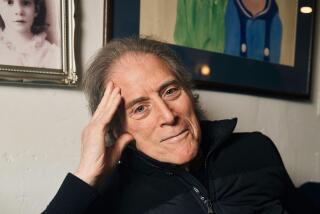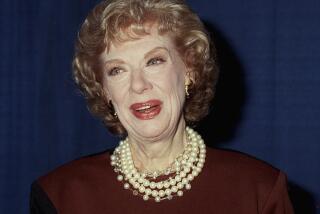From the Archives: Comedian Martha Raye Dead at 78
Martha Raye, the charismatic comedian with the oversized mouth, polished pratfalls and mimicking manner, died Wednesday in Los Angeles.
Miss Raye, born in a charity ward to Irish immigrant vaudevillians, was 78 and had been in failing health for many years.
Ron Wise, spokesman for Cedars-Sinai Medical Center where she died, said “her death follows a lengthy illness” including very severe circulatory problems.
For more than 50 years she had teamed up with the preeminent entertainment talents of the 20th Century: Charlie Chaplin, Jimmy Durante, Bob Hope, Al Jolson, Eddie Cantor, Milton Berle, Bing Crosby and many more.
She had opened her monstrous maw in Broadway musical comedies, radio and television shows and an assortment of motion pictures. And each time out of it came volume and warmth, for she had—if even for a fleeting moment—the ability to transcend foolishness and produce genuine sentiment and melancholy.
Nowhere was that more evident than during World War II and in Korea and Vietnam, when she traveled tens of thousands of miles to carry her merry insanity to American troops.
Her performances on film, a medium for which she first became well known, included a rendition of “Mr. Paganini,” in the 1936 Crosby film “Rhythm on the Range,” which made her an overnight star; “The Big Broadcast of 1938,” “Hellzapoppin” in 1941 and dozens of perfunctory, long-forgotten and low-budget pictures including “Give Me a Sailor,” “Never Say Die” and “$1,000 a Touchdown.”
She told the New York Times in a 1972 interview that she felt she had been badly used in pictures, making an exception for “Rhythm on the Range” and “Monsieur Verdoux,” in which she portrayed Annabella Bonheur, the cacophonous, domineering wife of Chaplin, a Bluebeard who satisfies her demands for money by secretly marrying and murdering rich women.
Chaplin, who told Miss Raye he had her in mind when he wrote the part, called it “the most brilliant film he had ever made”; some critics agreed and said it marked a return to his early triumphs in silent pictures.
Miss Raye acknowledged that it may have been her only venture into “art.”
At 5 foot, 3 inches, she was much smaller than her professional persona. It was when she smiled or spoke that people realized they were in the presence of a genuinely oversize personality with volume to match. Her personal appearances had been known to turn into celebrations. Her self-deprecating manner encouraged everyone around her to share in the warmth and belly laughs she tried hard to find in life.
But the final years proved to be anything but that.
Ailments that had begun to plague her as a young star entertaining at Allied military bases in the mid-1940s continued to trouble her through her later years.
She suffered from anemia for many years, was found unconscious on the beach in Malibu in 1962, suffered a series of strokes that forced her to use a wheelchair, and in October, 1993, underwent heart bypass surgery and treatment for gangrene poisoning in her foot.
She was married seven times, most recently to Mark Harris, a show business promoter 32 years her junior who had been trying to get her awarded the Presidential Medal of Freedom to go with the Motion Picture Academy’s Jean Hersholt Humanitarian Award Oscar she had received in 1968 for entertaining troops.
His efforts proved successful and in November, President Clinton awarded her the medal, citing her “great courage, kindness and patriotism.”
Those were among the happiest moments of her life.
Then there were the legal battles with ex-husbands and her daughter over her $2.5-million estate. At the end she had been hugely successful and ravishingly hungry, loved by audiences but often ignored by those whose love she sought. During periods she described as filled with melancholy, she said sadly that her career had really been “my whole life.”
Miss Raye and her mother had hoped she would become a serious singer when they sat down with the telephone book in 1929 to find a more suitable name for Margaret Teresa Yvonne O’Reed, who had become part of her parents’ vaudeville act. Martha Raye was an amalgam of what they found.
At 13 she was entertaining in nightclubs while performing with the Benny Davis Kid Revue. Her first big break came when she landed a small part in an all-star revue called “Calling All Stars.” It featured many of Broadway’s top players, including Phil Baker, Lou Holtz, Ella Logan and others. Miss Raye said years later that “the only two unknowns in the whole show were Judy Canova and me.”
One night Logan was too ill to perform and Miss Raye was dropped into her spot. Foreshadowing the corny plots of some of the pictures in which she later appeared, the evening made her a success.
By the time she made “Rhythm on the Range” she had been married a couple of times—to makeup artist Buddy Westmore and composer David Rose—but after several routine pictures in the mid- and late 1930s she tired of Hollywood and returned to Broadway. There she co-starred with the legendary Al Jolson in “Hold On to Your Hats,” a 1940 musical revue that ran for 158 performances. Jolson made her a regular on his radio show for the next two years, where she worked with such comics as Cantor, Hope and Durante.
In 1944 she came back to Hollywood for “Four Jills in a Jeep,” a wartime film built around the antics of four female entertainers touring bases in England and North Africa. The New York Post wrote that she had “never been more raucous, rough and pleasing.”
After “Monsieur Verdoux,” she gravitated toward television, doing several guest shots with Milton Berle, who had the nation’s No. 1 program in the early 1950s. Finally, after a series of summer replacement programs, she became host of “The Martha Raye Show” (1955-56). A New York Herald Tribune critic called her “the unqualified queen of buffoons.” She had been nominated for an Emmy in 1952 and 1953 for some specials and received another nomination in 1975 for an episode of “McMillan and Wife.”
She did sketches on other people’s programs throughout the 1950s and in 1958 began to appear on the New York stage in revivals (“Annie Get Your Gun”) and nationwide in repertory theater. Her interpretations of “No, No Nanette,” “Wildcat” and “Hello, Dolly” were particularly praised.
From 1982 to 1984 she was seen on TV in the long-running series “Alice,” which starred Linda Lavin as the acerbic waitress, and was one of dozens of stars featured on the comedy anthology “Love, American Style.”
In 1985, at age 69, the boisterous mistress of slapstick returned to a New York cabaret, this time to one called the Ballroom, where she sang classic ballads as they were written, sans the Raye sarcasm and gestures.
It was the second time she had switched from her comedy style. The first was in the early 1930s when her husband at the time, composer Rose, had her record such popular ballads as “Body and Soul,” an experience that she said “brought me 58 cents in royalties.”
This time the response to “Little Girl Blue,” “My Funny Valentine” and others was enthusiastic and profitable.
By then her only national appearances were on TV commercials in which she espoused the advantages of Polident, a denture cleaner. She said she enjoyed the commercials because a season’s worth were filmed in three days.
There were to be no more performances. The rest of her years were marked by court actions in which her daughter tried to declare her mentally incompetent and her friends split over her marriage to Harris, some of them hinting that it was only a money arrangement for him while others took his side, saying he had made a physically failing and mentally diminished old woman happy.
In another lawsuit, she alleged that the 1991 Bette Midler-James Caan film “For the Boys” wrongfully appropriated her life story. The lawsuit was dismissed this year after Midler testified that there was no similarity between her part and Miss Raye’s life except for the fact that they both entertained troops.
Columnist Sidney Skolsky, in a 1962 interview in which Miss Raye briefly lowered her comedic barriers, quoted her as saying: “Few people actually know me, or take me seriously. . . . It’s great for my career though, I guess.”
And then: “I thought success in show business was the answer to everything. It isn’t. I don’t know what is.”
From the Archives: Johnny Carson Defined Late-Night TV
From the Archives: The Master of the One-Liner
From the Archives: Isabel Sanford, 86; Won Emmy for Best Actress in a Comedy
From the Archives: Italian-born tile setter who built the Watts Towers
From the Archives: Billy Barty; Diminutive Entertainer
More to Read
Start your day right
Sign up for Essential California for the L.A. Times biggest news, features and recommendations in your inbox six days a week.
You may occasionally receive promotional content from the Los Angeles Times.






